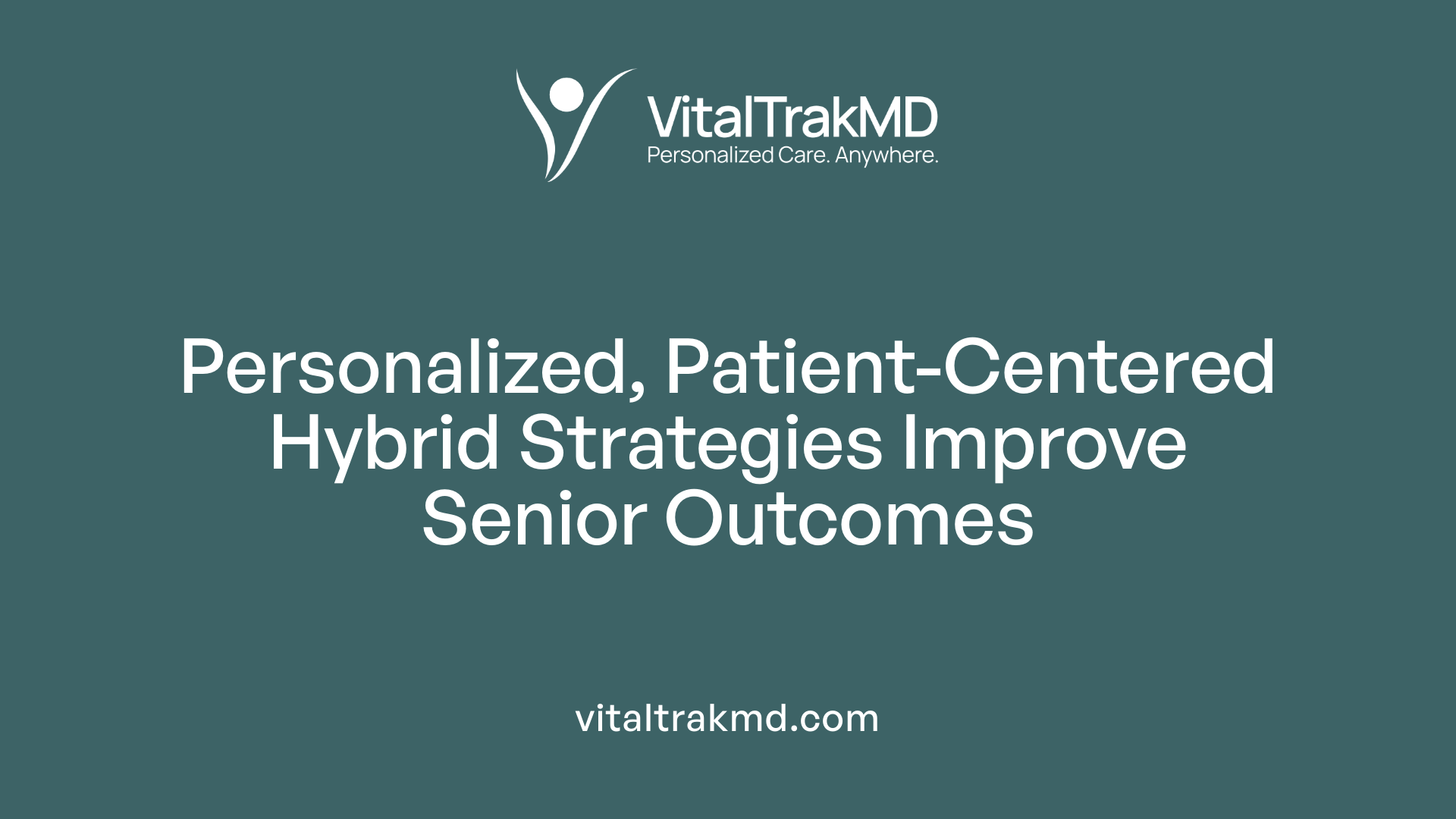The Role of Hybrid Care in Promoting Senior Engagement in Health Goals

Introduction to Hybrid Care and Senior Engagement
As populations age worldwide, innovative healthcare delivery models become crucial to meet seniors’ unique needs. Hybrid care, which combines in-person visits with digital health solutions, is emerging as a powerful tool to foster active participation and adherence among older adults. This article explores how hybrid care strategies enhance healthcare engagement, improve outcomes, and shape future directions in senior health management.
Components and Benefits of Hybrid Care Strategies for Seniors
What are the components and benefits of hybrid care strategies for seniors?
Hybrid care strategies for older adults combine traditional in-person healthcare with innovative digital technologies. This integrated approach uses tools like telemedicine, remote patient monitoring, and AI-driven diagnostics to create a more flexible healthcare system.
A central component of hybrid care is the continuum of services that spans hospitals, outpatient clinics, and the home setting. Seniors can receive initial assessments and treatments in hospitals while continuing ongoing management remotely from their homes. Digital platforms and tools enable continuous monitoring of vital signs, symptoms, and medication adherence, supporting proactive care.
These models place a strong emphasis on personalization. Care plans are tailored to individual needs, health priorities, and preferences, making the process more patient-centered. Such personalization ensures that care is relevant and engaging, encouraging better adherence and satisfaction.
Accessibility is significantly improved through hybrid strategies. Seniors often face barriers like transportation issues or physical limitations that hinder frequent visits. Remote options help overcome these obstacles, offering safe and convenient access to care without the need for travel.
Flexibility is another advantage. The hybrid system adapts to the evolving health status of older adults, allowing for more frequent communication and adjustments to treatment plans. This responsiveness enhances safety by enabling early detection of issues and timely intervention.
Safety is further reinforced through digital solutions that facilitate real-time data sharing and alerts for urgent health changes. Care providers can monitor seniors remotely, reducing emergency visits and hospitalizations.
Resource management also benefits. Virtual visits and remote monitoring decrease demand for hospital beds and decrease costs related to transportation and staff time. Digital tools help streamline workflows, making healthcare delivery more efficient.
Overall, hybrid care strategies improve the capacity of health systems to respond to the needs of aging populations. They enhance patient and caregiver engagement, promote safety, and optimize resource use, supporting holistic well-being for seniors.
| Component | Description | Additional Benefits |
|---|---|---|
| In-person services | Face-to-face assessments, treatments, and emergency care | Builds trust, physical exams, immediate intervention |
| Telemedicine and virtual consults | Remote medical consultations via video or phone | Convenient, reduces travel, quick access to specialists |
| Remote patient monitoring | Continuous health tracking through digital devices | Early detection, improved management, safety alerts |
| Digital health platforms | Patient portals, scheduling apps, online education resources | Engagement, empowerment, better communication |
| Personalized care plans | Tailored treatments based on individual needs and preferences | Increased adherence, satisfaction |
This layered approach creates a resilient, adaptable healthcare system that effectively meets the complex needs of older adults. It supports aging in place, reduces healthcare disparities, and promotes overall quality of life.
Enhancing Senior Engagement through Virtual and In-Person Care Integration
How does virtual and in-person care integration promote senior health engagement?
Integrating virtual and in-person care creates a more accessible healthcare environment for older adults. This combined approach allows seniors to participate actively in their health management from the safety and comfort of their homes, reducing the need for frequent trips to healthcare facilities.
Digital health tools like remote monitoring devices and telehealth consultations enable proactive management of chronic diseases. These tools provide continuous data on health metrics and facilitate early interventions, which can prevent disease worsening and reduce the necessity for hospital visits.
Connected digital platforms support seamless sharing of health information among different healthcare providers. This flow of information helps craft personalized care plans tailored to each senior’s unique needs, preferences, and health goals. Such tailored approaches foster a sense of involvement and control over one’s health.
Virtual care models also lessen caregiver burdens by offering more flexible support options and reducing logistical challenges related to transportation. This flexibility often results in higher satisfaction levels among seniors and their caregivers.
In addition, frameworks like the 4Ms—mentality, medications, mobility, and what matters most—are integrated within this hybrid model to enhance person-centered care. These strategies help address the holistic needs of seniors, encouraging adherence and engagement.
Despite these benefits, overcoming barriers such as technological literacy, access disparities—especially among those in underserved communities—and communication hurdles remains crucial. Providing targeted education, improving digital literacy, and ensuring equitable access to technology are vital steps to fully realize the potential of integrated virtual and in-person care for seniors.
Supporting Older Adults’ Participation in Health Goals with Hybrid Healthcare

What role does hybrid healthcare play in supporting older adults' participation in their health goals?
Hybrid healthcare is increasingly recognized as a valuable approach for engaging older adults in managing their health. This care model blends in-person visits with digital health solutions such as telehealth, remote monitoring, and online education, creating a flexible and accessible environment.
For older adults, mobility challenges, transportation barriers, and limited access to healthcare facilities can hinder consistent participation in health management. Hybrid models help overcome these obstacles by providing remote options that fit their lifestyle and preferences. Virtual consultations allow seniors to connect with their healthcare providers from the safety and comfort of their homes, reducing the need for travel and waiting times.
In addition, remote monitoring devices enable continuous tracking of health metrics like blood pressure, glucose levels, or mobility data. These real-time insights help providers tailor care plans and intervene early if issues arise, fostering proactive engagement.
Digital tools such as mobile health apps and patient portals further empower older adults by giving them easy access to their health information, medication reminders, and educational resources. This reinforces self-management behaviors and instills confidence in their ability to participate actively in their health goals.
Moreover, hybrid healthcare enhances the coordination of care. Regular communication between providers across different settings ensures consistency and reduces the chances of gaps in treatment. It supports long-term engagement, especially crucial for managing chronic conditions common among seniors.
Overall, this integrated approach promotes greater autonomy by respecting individual needs and preferences. It creates an environment where older adults feel supported, informed, and motivated to pursue their health objectives, thus improving health outcomes and quality of life.
| Aspect of Care | Description | Benefits |
|---|---|---|
| Virtual Consultations | Remote video or phone visits with healthcare providers | Reduced travel barriers, increased frequency of interactions |
| Remote Monitoring | Use of devices to track health metrics | Early detection of issues, personalized care adjustments |
| In-Person Visits | Essential face-to-face assessments and procedures | Maintains personal connection, complex assessments |
| Digital Education & Tools | Apps, portals, and online resources | Increased health literacy, active patient participation |
| Care Coordination | Ongoing communication among care teams | Consistent, comprehensive management |
This hybrid approach ultimately empowers older adults, fosters independence, and supports sustained engagement in achieving personalized health goals.
Current Trends and Future Directions in Hybrid Healthcare for Aging Populations

What are the current trends and future directions in hybrid healthcare for aging populations?
Hybrid healthcare is transforming the way health services are delivered to older adults. One of the most notable trends has been the rapid expansion of telehealth services during the COVID-19 pandemic. As a result, more than half of Americans now use virtual care options, making healthcare more accessible, especially for seniors who face mobility or transportation challenges.
This model combines in-person visits with digital solutions like telemonitoring, online education, and remote consultations. It benefits rural, underserved, and homebound seniors by reducing the need for travel, decreasing wait times, and fostering continuous communication between patients and healthcare providers.
Looking ahead, the integration of advanced technologies will shape hybrid healthcare's evolution. Artificial intelligence (AI), wearable devices, and smart home systems are being developed to enable personalized health management. Wearables can continuously track vital signs, alerting providers to potential issues early. AI-powered algorithms analyze health data, supporting proactive interventions and tailored care plans.
Innovations are also being explored in senior living environments. Smart homes equipped with sensors promote safety and independence while facilitating social interactions among residents. Robotics are being tested for assistance with daily activities, companionship, and health monitoring.
Holistic, person-centered care plans are becoming a focus, leveraging big data analytics to understand individual health goals, social circumstances, and preferences. These plans aim to coordinate medical, social, and mental health services, creating a seamless experience.
Future directions include fostering greater health equity. Programs offering technology access and digital literacy training are critical in bridging disparities, especially for marginalized populations. Efforts to adapt digital tools to cultural and language needs will also enhance engagement.
In summary, hybrid healthcare is set for further growth, driven by technological advances and a shift towards more personalized, holistic, and inclusive care. This evolution promises to improve health outcomes, sustain independence, and enrich quality of life for aging populations worldwide.
Evidence and Scientific Perspectives Supporting Hybrid Care Effectiveness
What does the latest evidence suggest about the effectiveness of hybrid care in enhancing health engagement among seniors?
Recent studies and trials highlight the significant benefits of hybrid care models in improving health engagement among older adults. These models combine in-person visits with digital solutions, creating a flexible and accessible approach tailored to individual needs.
Research involving multi-site, hybrid type I and II trials indicates that hybrid care enhances accessibility by reducing travel time and transportation barriers. It fosters stronger physician-patient relationships through more frequent interactions, whether virtual or face-to-face. For seniors, this continuous touchpoint supports better understanding of their health conditions and encourages active participation in care decisions.
Evidence shows that hybrid models can effectively address common challenges faced by older populations, such as social isolation and digital literacy issues. Incorporating community-based approaches, like the HOPE-FIT program, further promotes engagement by aligning care with seniors’ personal health goals and social contexts.
The integration of various digital tools—including telehealth consultations, remote monitoring devices, and online education—allows for ongoing management of chronic conditions and injury rehabilitation. These tools are especially valuable in rural and underserved areas, where access to healthcare is limited.
Particularly during the COVID-19 pandemic, the rapid expansion of telehealth services demonstrated their role in maintaining treatment continuity and reducing risks associated with in-person visits. Studies have found that virtual care supported not only medical management but also emotional and social well-being, which are crucial for older adults.
In summary, robust scientific data affirm that when implemented thoughtfully, hybrid healthcare models effectively boost engagement, improve health outcomes, and support aging in place. They address barriers such as limited mobility, provider shortages, and healthcare disparities, making them highly suitable for diverse senior populations.
| Study Type | Focus Area | Outcomes | Additional Details |
|---|---|---|---|
| Multisite Trials | Chronic disease management | Increased patient engagement, better adherence | Demonstrated improved health insight and shared decision-making |
| Community-based Programs | Social support and social determinants | Reduced social isolation, enhanced participation | Tailored interventions for enhancing social and emotional well-being |
| Telehealth Innovations | Rural healthcare access | Reduced travel burden, timely diagnosis | Facilitated care coordination among local providers and specialists |
| Randomized Controlled Trials | Older adult health engagement | Improved communication and health ownership | Highlighted the role of digital literacy initiatives |
Overall, the evidence underscores that hybrid care, by combining personal interaction with digital convenience, offers a promising pathway to sustain and improve health engagement among seniors, especially in challenging environments such as remote and underserved communities.
Strategies to Optimize Health Outcomes in Hybrid Care for Seniors
How can strategies within hybrid care optimize health outcomes for seniors?
Hybrid healthcare combines both in-person visits and digital solutions to create a flexible approach tailored to senior patients. This method enhances access, especially for those in rural or underserved areas, by reducing the need for travel and enabling continuous care. It supports remote monitoring tools, telemedicine consultations, and home-based rehabilitation programs that help manage chronic conditions effectively.
To ensure optimal results, integrating technology with electronic health records allows for seamless information sharing among healthcare providers. Supporting patients and caregivers with digital literacy training and providing necessary equipment fosters confidence in using these tools.
Personalization is crucial; care pathways should be adapted based on individual health needs and preferences. For example, older adults usually prefer simplified applications, while younger seniors might engage with more detailed data and interactive features.
Involving caregivers in the care process and offering support with technology usage enhances adherence and long-term engagement. Regular virtual interactions strengthen the physician-patient relationship, providing reassurance and timely interventions.
Improved communication and continuity of care are fundamental. Using digital channels like patient portals, secure messaging, and scheduled video calls enables ongoing dialogue, making health management more responsive.
Overall, strategies that combine technological innovation with personalized, human-centered care significantly improve health outcomes for seniors. This integrated approach not only addresses logistical barriers but also empowers older adults to take an active role in their health, leading to better management of chronic conditions and improved quality of life.
The Significance of Telehealth and Technology in Senior Care

What is the significance of telehealth and technology in engaging seniors in health management?
Telehealth and technology are transforming how seniors experience healthcare by providing access to a broad spectrum of clinical services. These digital tools include virtual consultations, remote monitoring, and digital lifestyle interventions that enable seniors to manage their health proactively from the comfort of their homes.
One of the main advantages is supporting aging in place. By reducing the need for transportation and minimizing physical barriers, telehealth facilitates ongoing care and early detection of health issues. This approach not only improves health outcomes but also helps in preventing unnecessary hospitalizations, which are often disruptive and costly.
Age-friendly digital platforms are designed to be accessible and simple, with personalized onboarding processes that cater to individual needs and preferences. For example, older adults may prefer simplified interfaces that focus on essential information, while younger seniors may appreciate more detailed and complex data.
Strong clinician-senior relationships are fostered through regular virtual interactions. These consistent communications help build trust, encourage active participation, and enable timely interventions. Importantly, these digital solutions also promote family involvement, which can be crucial in managing chronic conditions or disabilities.
However, challenges like technological literacy gaps and disparities in access persist. Not all seniors are familiar with or have reliable internet access to fully utilize these systems. To bridge this divide, targeted strategies such as education programs, caregiver support, and policy initiatives are essential.
Overall, the integration of telehealth and technology in senior care aims to empower older adults, enhance their engagement, and improve their quality of life. With continued innovations and supportive policies, these tools can ensure more equitable and effective healthcare delivery for aging populations.
Perspectives on Hybrid Care and Senior Engagement from Scientific and Academic Domains

What are the scientific perspectives on the effectiveness of hybrid care in promoting senior health engagement?
Research and expert analysis increasingly support the idea that hybrid healthcare models effectively foster greater engagement among older adults. These models blend in-person visits with digital health tools, making healthcare more accessible and tailored to individual needs.
Studies focusing on aging populations and chronic condition management highlight several benefits. For example, seniors with mobility challenges or living in rural areas find it easier to participate actively in their care when virtual options are available. This reduces transportation barriers and long travel times, encouraging consistent follow-up and adherence.
A notable area of research involves hybrid approaches to managing chronic diseases such as hypertension, diabetes, and dementia. Data from various studies reflect that these models lead to higher patient satisfaction, improved communication, and better health outcomes.
The COVID-19 pandemic played a crucial role in expanding the use of hybrid care, demonstrating its potential during crises to maintain continuous care. During this period, healthcare providers reported faster integration of hybrid methods into routine practice.
Empirical evidence suggests these models are particularly beneficial for vulnerable groups, including seniors with multiple health conditions or those in underserved areas. They facilitate more frequent, meaningful interactions with healthcare providers, which enhances understanding, adherence, and overall engagement.
Moreover, research shows that hybrid systems promote health equity by lowering disparities in access to specialist care and routine health management. They also support the efficient use of healthcare resources, reducing unnecessary hospital visits and enabling timely interventions.
In conclusion, scientific perspectives affirm that integrating digital and in-person care approaches significantly boosts health engagement among seniors. As healthcare systems continue to evolve, evidence supports continued investment in hybrid models to improve quality, access, and equity of care for older populations.
Search query: Scientific perspectives on hybrid care effectiveness for seniors
Patient-Centered Care and Its Impact on Health Outcomes for Seniors

How does patient-centered care in hybrid models improve healthcare outcomes for seniors?
Patient-centered care (PCC) within hybrid healthcare models significantly enhances health outcomes for seniors by prioritizing their individual needs, preferences, and health goals. This personalized approach makes treatment plans more relevant and adaptable, increasing patient engagement and satisfaction.
In the context of a hybrid system—which combines in-person visits with digital health tools—PCC helps tailor care pathways that fit senior patients’ unique circumstances. For example, digital elements such as remote monitoring, online education, and personalized communication empower patients to take an active role in managing their health.
Studies show that seniors receiving PCC in hybrid models often experience improved physical and mental health outcomes. They are less likely to be readmitted to hospitals, which not only benefits their well-being but also eases the burden on healthcare facilities. The continuity of care enabled by hybrid systems fosters stronger provider-patient relationships, fostering trust and better adherence to treatment plans.
Effective communication strategies, including clear instructions and empathetic interactions, bolster patient empowerment. These foster a sense of ownership over health decisions, making seniors more likely to follow prescribed therapies and lifestyle adjustments.
Aligning care with patient preferences is crucial. This means incorporating what matters most to seniors—for some, that might be maintaining independence; for others, managing pain or mental health. Personalizing goals helps reduce unnecessary interventions and prevents over-treatment, which can harm health or reduce quality of life.
Despite some challenges such as technological literacy gaps or resource limitations, implementing PCC in hybrid models offers an effective way to improve health outcomes, especially for aging populations with multiple chronic conditions. It ensures care is responsive, respectful, and truly centered on the individual, leading to healthier, more satisfied seniors.
Shaping the Future of Senior Healthcare
As healthcare systems adapt to the needs of aging populations, hybrid care models stand out as a vital strategy to foster active engagement among seniors. They combine the personalized touch of in-person care with the convenience and reach of digital technology, creating an integrated environment conducive to better health outcomes, higher satisfaction, and greater autonomy. The ongoing evolution of technologies like AI, wearables, and smart home systems promises to revolutionize senior health management, making care more holistic and accessible. Addressing challenges like digital literacy and disparities will be crucial, but with strategic policy and community support, hybrid care can lead the way in equitable, effective senior healthcare—empowering older adults to lead healthier, more engaged lives.
References
- Patient Engagement in a Hybrid Care Pathway for ...
- What Is Hybrid Healthcare? | Tools, Benefits, and Solutions
- Empowering Patients Through Virtual Care Delivery
- Hybrid Health Care for Seniors
- How a hybrid approach to telehealth improves patient care ...
- A hybrid type 1 trial protocol of patient priorities care for ...
- Hybrid approach to telehealth effective in rural communities
- Preparing patients for hybrid care
- Designing for flexibility in hybrid care services - PubMed Central
- What Is Hybrid Healthcare? - AC Health
Recent articles
Want to Feel Better and Live Healthier?
Join hundreds of patients taking control of their health with personalized care that fits their life – not the other way around.
Rated 4.8/5 by 32+ customers







